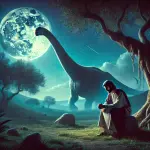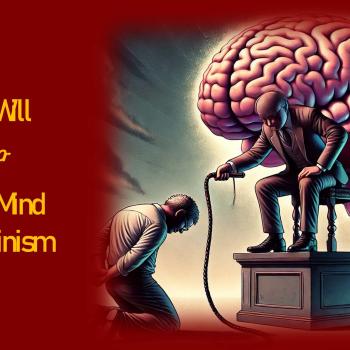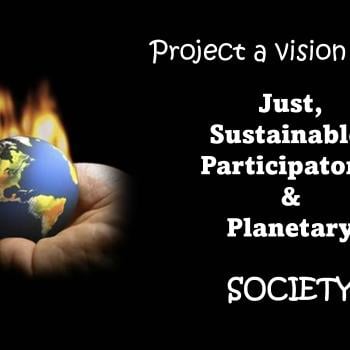UAP in science? Let’s ask Robert Powell
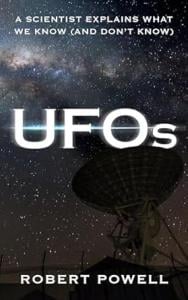
Last Saturday, February 15, 2025, Robert Powell’s new book was featured at the SUAPS (Society for UAP Studies) Community Reading Circle. What book? It’s UFOs: A Scientist Explains what we know (and don’t know) (Powell 2024). Robert Powell, if you don’t yet know him, is the co-founding director of the Scientific Coalition for UAP Studies (SCU). From 2007 to 2017 he directed research at MUFON and established MUFON’s science review board. He is also a member of the Society for Scientific Exploration, the UFODATA project, and the National Space Society. UAP in science? Yes, indeed.
“The answer to the UFO phenomenon must come from the world of science and academia” (Powell 2024, 120). This is the melody Robert Powell hums continuously. But the scientific choir needs to get on key. Why? Because of flat notes due to the stigma previously associated with UFOs. UAP researcher Brenda Denzler has her ear to the discord.
“For most professional scientists … the fear of ridicule and loss of professional status prevented them from pursuing an active interest in UFOs …. But fear of public ridicule did not prevent scientists from having a privately respectful interest in the subject” (Denzler 2001, Kindle 1150-1151).
We need a choir without such discord if UAP in science will harmonize. So, “it will require a new attitude for how science approaches a solution to UAP. There will need to be openness and a willingness for scientists to study the history of the subject so that they can understand the basic scope and nature of the problem” (Powell 2024, 141). Scientists may need to stretch their hypotheses to consider the possibility that we are dealing here with nonhuman intelligence. Are we ready? Yes.
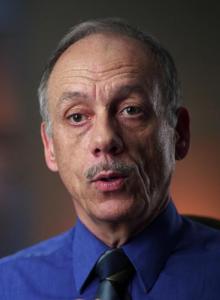
Since 2017, a sea change has taken place in UAP studies. “Attitudes toward UFOs have changed. This is demonstrated by the existence of organizations such as SCU [Scientific Coalition for UAP Studies] and GP [Galileo Project]. The rebranding of the word UFO to UAP was arguably instrumental in that change” (Powell 2024, 140). Evidently the change from UFO to UAP reduced the amount of giggling among our scientists. We’ve seen a leap in the number of white lab coats working on the phenomenon not only in SCU and GP but also SUAPS, the Sol Foundation, and others. Robert Powell’s melody is being sung widely these days.
FYI: should you wish to extend the discussion of the interaction between science and religion within the UFO phenomenon, see the video interview, “Religion + UFPs?,” on Coffee and UFOs with Alan Smith and Ted Peters.
UAP in science. And beyond science
I for one welcome the new tune! I’m grateful to Robert Powell and his colleagues for putting UAP in science.

Yet, there is more to UAP than science under its current materialist restrictions can investigate (Zeller Nov 2021). Because scientists restrict themselves – for very good reasons! – to explanations that rely on material causes, some dimensions of the UFO phenomenon go unattended. What goes unattended are subjective manifestations such as the sense many witnesses have that the anomalous object in the sky is establishing a personal connection. What also goes unstudied scientifically are curious paranormal occurrences, abduction reports, and the rise of UFO religious beliefs (Tumminia 2003). Finally, many UFO experiencers report dramatic changes in their ontology, their worldview, their viewpoint on the nature of reality as a whole.
Independent scholar Jensine Andresen coins the term, hyperconvergence, to draw our attention to the scope and nuance of the phenomenon.
“Hyperconvergence refers to two types of convergences—which also are converging. At the broad level, there is the convergence of categories of human thinking and behavior, namely religion/theology, politics/geopolitics, and technology …. At the same time, and more granularly, one finds tremendous narrative convergence around the UAP topic. This occurs when rapidly proliferating narrative strands relating to ETI/UAP either come together and reinforce one another or collide and oppose one another. Combining categorical and narrative convergence results in the hyperconvergence one sees in many aspects of society today. One of the greatest downside risks of hyperconvergence is that it creates confusion in people’s minds, and confused people are not known to act rationally” (Andresen, Hyperconvergenece, 2023, 30-31).
One the one hand, we’ve put UAP in science. Hooray! On the other hand, we need to open a gate to reality outside the fence of science. Jeffrey Kripal of Rice University leaps the fence.
“’Shut up and calculate’ was the norm of physics for much of the twentieth century. That kind of snarky attitude got people jobs and gave us much of our modern technology, including the nuclear bomb and modern computer communication, but it also prevented any effective cultural integration of what we have learned about the physical world with our own human experience …. we are going to need the humanities …. (Kripal 2024, 14-15).
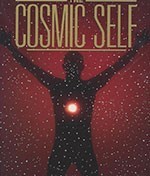 It’s not science that’s the problem. It’s reality itself. Stanford’s Richard Dolan recognizes that the very nature of reality is at stake.
It’s not science that’s the problem. It’s reality itself. Stanford’s Richard Dolan recognizes that the very nature of reality is at stake.
“A proper study of UFOs is a revolutionary experience. It shatters old belief systems and forces us to look at our world in a completely different way. Everything is affected: history, politics, economics, science, religion, culture, and out ultimate vision of who and what we are as human beings” (R. M. Dolan 2014, 2022, 2).
How then do we orchestrate a healthy convergence between the scientific method and extra-scientific dimensions of UAP? The Society for UAP Studies, among others, would like to expand the horizon of the scientific vision in order to incorporate these subjective and puzzling dimensions. Editor of the new journal, Limina, Michael Cifone, replaces the previous term, ufology, with UAP Studies. He wants to be “open to new possibilities.” By adopting a variant on the term liminal, Cifone invites “epistemological, methodological, and perhaps even an ontological zone of transition: one part within the known and accepted, and another oriented away from it” (Cifone 2024, 5).
Are UAP a military threat?
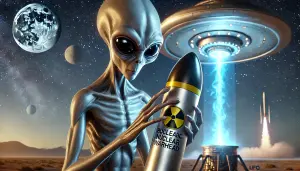
What are they? That’s the question UAP in science researchers investigate. But there are other questions, as we’ve just noted. Here’s one. Are UAP dangerous? Are they a MILITARY threat? If not, why are UFOs seen so frequently monitoring our nuclear facilities?
For three quarters of a century, anomalous flying craft have visited nuclear power sites and atomic weapon sites in the U.S. and elsewhere in the world. Repeatedly. Frequently. Former U.S. Air Force historian, Larry Hancock, asks whether national security is at stake. “We do have indications that unknown parties, possessing unconventional technology, monitored the development of the nation’s strategic atomic military capability” (Hancock 2017, 461). Should we on Earth build up our military capability so as to defend ourselves in a war against invading aliens?
Definitely not, contends Jensine Andresen. Andresen is convinced that UFOs are craft piloted by ETI. These ETI are benevolent, not malevolent. Don’t shoot them!
More importantly, our alien visitors are bringing a moral message to Earth. Stop war! Stop preparing for war with nuclear weapons. Here is the message from ETI to Earth’s human species. “Nuclear weapons are in fact hackable from a distance. You therefore must abolish all nuclear weapons on Earth, and you should not position nuclear weapons in space.” (Andresen, 2022, 312, Andresen’s emphasis).
Conclusion
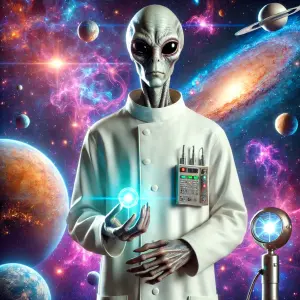
In my own work over the decades, I’ve admired the serious scientists who, like Sherlock Holmes, investigate the mystery. Robert Powell is today’s Sherlock.
Yet, we have seen how the UFO phenomenon includes more than just the kind of mystery a scientist is prepared to investigate. In one of my treatments, I suggest we think of ETH (the extraterrestrial hypothesis) within the UFO phenomenon in terms of four sub-models: (1) the interstellar diplomat or political model; (2) the research scientist or scientific model; (3) the celestial savior or religious model; and (4) the hybridizer or abduction model (Peters 2014). Each model may require a slightly different set of methodological tools to investigate. UAP Studies should employ as many methods as are available.
Patheos SR 1196 UFO 26 UAP in Science: Robert Powell
UAP’s Cryptoterrestrial Hypothesis
UFO 18 Are UAP from outer space?
UFO 19 Are UAP from future time?
UFO 20 Are UAP Extradimensional?
UAP and Ancient Alien Theology
UAP, ETI, and David Bohm’s Physics
▓

Ted Peters directs traffic at the intersection of science, religion, and ethics. Peters is an emeritus professor at the Graduate Theological Union, where he co-edits the journal, Theology and Science, with Robert John Russell on behalf of the Center for Theology and the Natural Sciences, in Berkeley, California, USA. He authored Playing God? Genetic Determinism and Human Freedom? (Routledge, 2nd ed., 2002) as well as Science, Theology, and Ethics (Ashgate 2003). Along with Martinez Hewlett, Joshua Moritz, and Robert John Russell, he co-edited, Astrotheology: Science and Theology Meet Extraterrestrial Intelligence (2018). Along with Octavio Chon Torres, Joseph Seckbach, and Russell Gordon, he co-edited, Astrobiology: Science, Ethics, and Public Policy (Scrivener 2021). Along with Arvin Gouw and Brian Patrick Green, he co-edited Religious Transhumanism and Its Critics (Lexington 2022). He is also author of UFOs: God’s Chariots? Spirituality, Ancient Aliens, and Religious Yearnings in the Age of Extraterrestrials (Career Press New Page Books, 2014). Look for his newest book, The Voice of Public Theology, a collection of previous articles. See his website: TedsTimelyTake.com.
▓
References
Andresen, Jensine. 2023. Hyperconvergenece: Religion, Politics, and UFOs. Independent: https://www.goodreads.com/book/show/197292604-hyperconvergence.
Cifone, Michael. 2024. “Editorial.” Limina 1:1 3-7; https://limina.scholasticahq.com/article/92781-editorial.
Denzler, Brenda. 2001. Lure if the Edge: Scientific Passions, Religious Beliefs, and the Pursuit of UFOs . Berkeley CA: University of California Press.
Dolan, Richard M. 2014, 2022. UFOs for the 21st Century Mind. San Mateo CA: Richard Dolan Press.
Hancock, Larry. 2017. Unidentified: The National Intelligence Problem of UFOs . Southgate TX: Treatise.
Kripal, Jeffrey. 2024. , How to Think Impossibly: About Souls, UFOs, Time, Belief, and Everything Else . Chciago: University of Chicago Press.
Peters, Ted. 2014. UFOs–God’s Chariots? Spiritualiy, Ancient Aliens, and Religious Yearnings in the Age of Extraterrestrials. 2nd. Pompton Plains NJ: New Page Books.
Powell, Robert. 2024. UFOs: A Scientist Explains What we Know and Don’t Know. Lanham MD: Roman and Littlefield.
Tumminia, Diana. 2003. “From Rumor to Postmodern Myth: A Sociological Study of the Transformation of Flying Saucer Rumor.” In Encyclopedic Sourcebook of UFO Religions, by ed James R Lewis, 103-119. Amherst NY: Prometheus.
Zeller, Benjamin. Nov 2021. “(Dis)Enchanted Ufology.” Nova Religio 25:2 61-86.
Zimmerman, Michael. 1997. “The alien abduction phenomenon: Forbidden knowledge of hidden events.” Philosophy Today 41:2 235-245.



